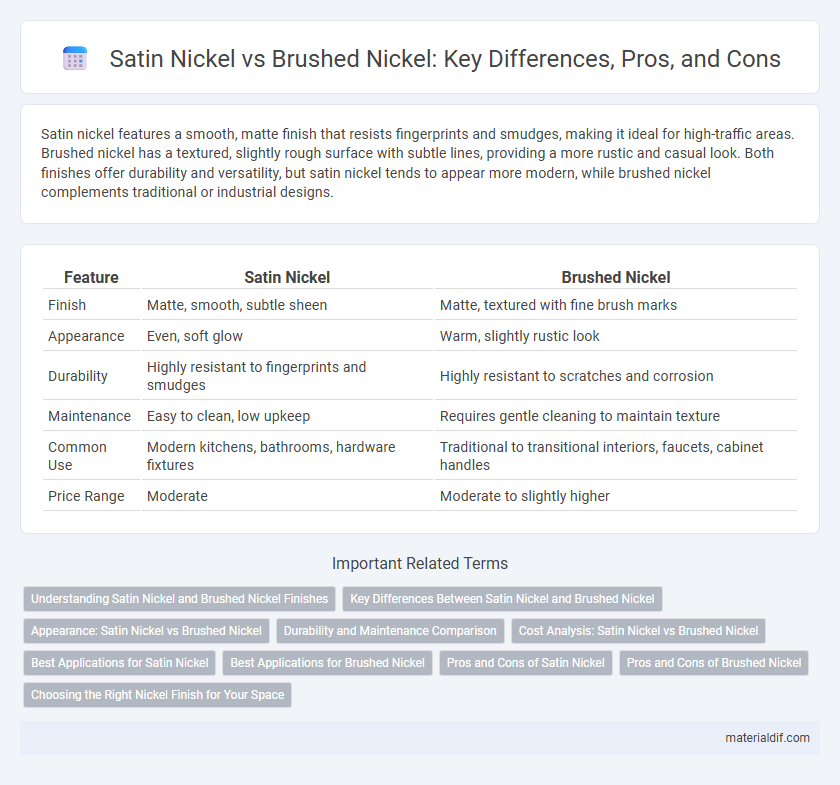Satin nickel features a smooth, matte finish that resists fingerprints and smudges, making it ideal for high-traffic areas. Brushed nickel has a textured, slightly rough surface with subtle lines, providing a more rustic and casual look. Both finishes offer durability and versatility, but satin nickel tends to appear more modern, while brushed nickel complements traditional or industrial designs.
Table of Comparison
| Feature | Satin Nickel | Brushed Nickel |
|---|---|---|
| Finish | Matte, smooth, subtle sheen | Matte, textured with fine brush marks |
| Appearance | Even, soft glow | Warm, slightly rustic look |
| Durability | Highly resistant to fingerprints and smudges | Highly resistant to scratches and corrosion |
| Maintenance | Easy to clean, low upkeep | Requires gentle cleaning to maintain texture |
| Common Use | Modern kitchens, bathrooms, hardware fixtures | Traditional to transitional interiors, faucets, cabinet handles |
| Price Range | Moderate | Moderate to slightly higher |
Understanding Satin Nickel and Brushed Nickel Finishes
Satin nickel and brushed nickel finishes both offer a smooth, matte appearance with subtle texture, enhancing durability and resistance to fingerprints and tarnishing. Satin nickel features a softer, more muted sheen achieved by a fine abrasive treatment, resulting in a consistent, velvety look ideal for modern hardware and fixtures. Brushed nickel, distinguished by its visible directional brush strokes, provides a slightly more textured surface that hides scratches well, making it popular in kitchen appliances and bathroom fittings.
Key Differences Between Satin Nickel and Brushed Nickel
Satin nickel features a smooth, matte finish with a subtle sheen created through light polishing, while brushed nickel exhibits a more textured surface with visible brush strokes that enhance its rugged appearance. Satin nickel tends to resist fingerprints and smudges better, making it ideal for frequently touched fixtures, whereas brushed nickel's slightly rough texture can better conceal scratches and wear over time. Both finishes use nickel plating but differ in aesthetic appeal and maintenance requirements, influencing their suitability for various interior design applications.
Appearance: Satin Nickel vs Brushed Nickel
Satin nickel features a smooth, matte finish with a subtle sheen that softens the metal's appearance, giving it an elegant and contemporary look. Brushed nickel displays a more textured surface with fine brush strokes that create a slightly rough feel and a muted metallic luster, enhancing its industrial and rustic appeal. Both finishes resist fingerprints and tarnishing, but satin nickel offers a smoother, more uniform look, while brushed nickel highlights the natural metal grain.
Durability and Maintenance Comparison
Satin nickel features a smoother, more polished surface that resists corrosion and fingerprints better than brushed nickel, enhancing its durability in high-traffic areas. Brushed nickel exhibits a textured, matte finish that better conceals scratches and water spots, reducing the frequency of maintenance. Both finishes require regular cleaning with mild soap and water, but satin nickel's corrosion resistance often results in a longer-lasting, low-maintenance option for fixtures and hardware.
Cost Analysis: Satin Nickel vs Brushed Nickel
Satin nickel typically costs slightly more than brushed nickel due to its finer finish and increased resistance to tarnishing, which can extend the lifespan of fixtures and reduce long-term expenses. Brushed nickel, while more affordable upfront, may require more frequent cleaning or replacement due to its less durable surface. Considering installation and maintenance, satin nickel presents a cost-effective choice over time despite the higher initial price.
Best Applications for Satin Nickel
Satin nickel offers a smooth, matte finish that resists fingerprints and water spots, making it ideal for high-traffic areas like kitchen faucets and bathroom fixtures. Its subtle sheen complements modern and transitional design styles, enhancing cabinetry hardware and door handles with a sophisticated yet understated look. Satin nickel's durability and corrosion resistance make it well-suited for both residential and commercial applications where long-lasting performance is essential.
Best Applications for Brushed Nickel
Brushed nickel is best suited for high-traffic areas such as kitchen faucets, cabinet hardware, and bathroom fixtures due to its durable finish that resists fingerprints and water spots. Its textured surface enhances grip and maintains a subtle, matte appearance, making it ideal for practical and stylish home accents. This finish pairs well with contemporary and industrial design styles, offering both functionality and aesthetic appeal.
Pros and Cons of Satin Nickel
Satin nickel offers a smooth, matte finish that resists fingerprints and water spots, making it ideal for high-traffic areas and maintaining a clean appearance. Its warm, slightly muted tone complements various design styles, though it may show scratches more easily than brushed nickel, which has a more textured surface that better disguises wear. Satin nickel requires occasional maintenance to preserve its finish but provides a durable and elegant option for fixtures and hardware.
Pros and Cons of Brushed Nickel
Brushed nickel offers a contemporary, matte finish that resists fingerprints and water spots, making it ideal for high-use areas like kitchens and bathrooms. Its durability and ability to hide fingerprints provide a low-maintenance option compared to polished or satin finishes, though it may accumulate dirt and grime in the tiny grooves of its texture. Some users find that brushed nickel's darker tone lacks the bright luster of satin nickel, potentially limiting its appeal in more traditional or high-gloss design schemes.
Choosing the Right Nickel Finish for Your Space
Satin nickel offers a smooth, matte finish with subtle sheen, ideal for modern and contemporary interiors seeking a clean, understated look. Brushed nickel features a slightly textured surface with visible brush strokes, providing a warm, rustic charm that hides fingerprints and water spots effectively. Selecting between satin and brushed nickel depends on desired aesthetic and maintenance needs, with satin nickel favoring sleek simplicity and brushed nickel enhancing tactile, lived-in appeal.
Satin nickel vs Brushed nickel Infographic

 materialdif.com
materialdif.com